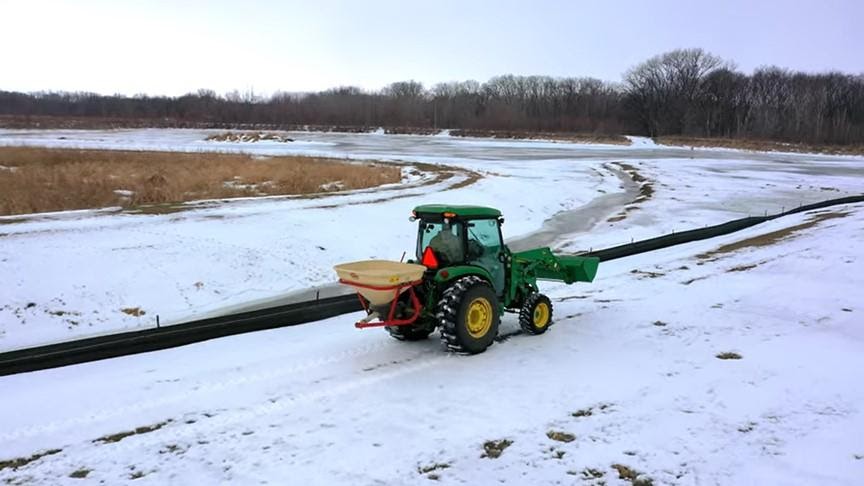
Throughout the temperate world, Mother Nature’s knack for nurturing and sustaining the life cycle of plants is incomparable. Seasonally, wildflowers and other seed-producing plants mature and spread their seed. At that point, in places that experience winter-like conditions and natural freeze and thaw cycles, the seed works its way into the soil. The spring thaw brings with it hydrated and fertile soil, providing ideal conditions for the seed to germinate and grow strong roots. This annual cycle forms the basis for farmers and landowners looking to utilize a popular and economical method for growing grasses, clovers, and wildflowers on their land – dormant or frost seeding.
Dormant seeding is utilized when plants are not actively growing, typically mid-November to early March. There are a number of ways to seed during this period. One that works well for areas where the ground freezes is frost seeding, which is placement of seed on the surface of frozen ground. It can be an effective and efficient approach to establishing valuable pollinator habitat. Land managers in Linn County, Iowa are utilizing dormant frost seeding to establish pollinator habitat on prairie land. Learn more about that effort in the video below.
Frost seeding uses a similar approach as other seeding methods. Farmers still need to follow the best practices for planting such as defining objectives, selecting a regionally appropriate seed mix, and proper site preparation by seeding time. Site preparation includes ensuring that the seeds have good potential for soil contact. We recommend you revisit our post from earlier this year highlighting the new Pollinator Habitat Establishment and Management Guide from the Bee and Butterfly Habitat Fund. The guide provides in-depth information for these steps, including the critical step of site preparation.
Choosing the right time to frost seed is vital. Late winter or early spring is the ideal time to seed as it allows for the seed to take advantage of the freeze and thaw cycles. The Natural Resources Conservation Service (NRCS) recommends avoiding frost seeding on heavy snow, and suggests the technique is most effective in non-sandy soils. This method can be ideal for seeding areas that might be difficult to access in wet seasons, such as low lying or wet areas or in field boundaries.
Broadcast spreading is the most common and preferred method for frost seeding, but drill seeding can also be used. The NRCS advises that cyclone-type spreaders that mount onto ATVs or tractor 3-point hitches are commonly used. When you have the seed mix and seeding rate you want to apply, the best time to perform frost seeding is early in the morning when the soil is frozen, and a thaw is expected during the day, according to Penn State University’s College of Agriculture Sciences. This allows the seed to lodge itself in the light snowpack and not be blown away in the winter winds, eventually making contact with the soil as the snow thaws. Doing so will reduce the chance for soil compaction while providing the desired soil heaving that improves seed-to-soil contact. Dry saw dust or other fillers can be used in the bulking of seed to make it easier to spread and see where you’ve planted.
The seeds will germinate in the spring, requiring regular maintenance to control weeds and encourage establishment in the first few growing seasons. Again, we refer you to the Pollinator Habitat Establishment and Management Guide for proper project maintenance.
Frost seeding is an efficient and economical way for farmers and land managers to establish and improve pollinator habitat. With a little fall preparation and some cooperation from Mother Nature, you can utilize the winter months to get ahead on establishing these critical pollinator resources on your farm.
